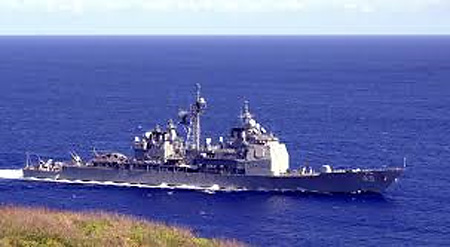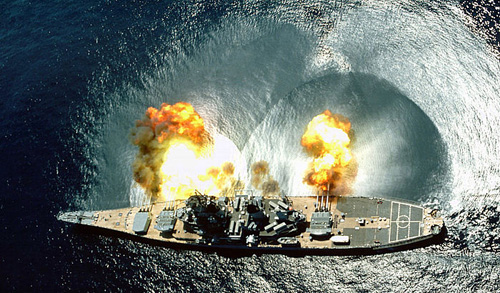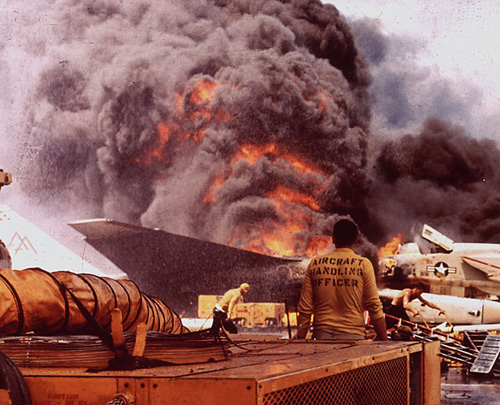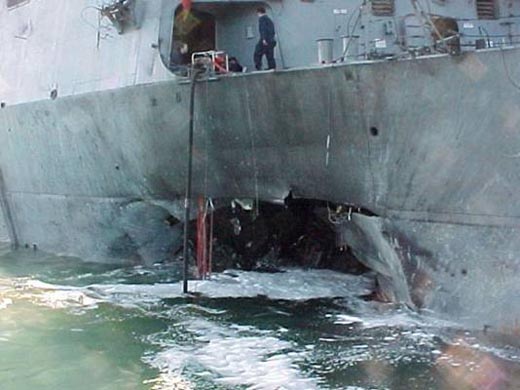Should America Fight For The Spratlys?Should America Fight For The Spratlys?2 diffrnt analysis.
The irony - US insists everybody else obey the international law of the sea based on the UN Law of the Sea Convention which the US itself has not ratified and most likely won't ever.
It appears that Washington, ever a seething cauldron of bright ideas, is looking for a shooting war with China, or perhaps trying to make the Chinese kowtow and back down, the pretext being some rocks in the Pacific in which the United States cannot possibly have a vital national interest. Or, really, any interest. And if the Chinese do not back down?
Years back I went aboard the USS Vincennes, CG-49, a Tico class Aegis boat, then the leading edge of naval technology. It was a magnificent ship, fast, powered by a pair of airliner turbines, and carrying the SPY-1 phased-array radar, very high-tech for its time. The CIC was dark and air-conditioned, glowing with huge screens – impressive for then – displaying all manner of information on targets in the air. Below were Standard missiles, then on a sort of chain drive but in later ships using the Vertical Launch System. It was, as they say in Laredo, Muy Star Wars. (The Vincennes was the ship that later shot down the Iranian airliner.)
 The Vincennes. The boxy thing up front is the radar. It is not hardened.
The Vincennes. The boxy thing up front is the radar. It is not hardened.Being something of a technophile, I took all of this in with admiration, but I thought – what if it gets hit? As a kid in my preteens I had read about the battleships of WWII, the Carolinas but in particular the Iowa class, fast, brutal ships with sixteen-inch belt armor and turrets that an asteroid would bounce off of. The assumption was that ships were going to get hit. They were built to survive and continue fighting.
By contrast, the Vincennes was thin-skinned, hulled with aluminum instead of steel, and the radar, crucial to combat, looked perilously fragile. A single hit with anything serious, or perhaps even a cal .50, but certainly by anything resembling a GAU-8, and she would be
hors de combat until refitted.
One hit. The Iowa, BB-61. I went aboard her at Norfolk at the Navy’s invitation. It altered my appreciation of guns. I came away thinking that if you can’t crawl into it, it isn’t really a gun. And solid: There is a reason why no battleship was sunk after Pearl Harbor.
The Iowa, BB-61. I went aboard her at Norfolk at the Navy’s invitation. It altered my appreciation of guns. I came away thinking that if you can’t crawl into it, it isn’t really a gun. And solid: There is a reason why no battleship was sunk after Pearl Harbor.I also knew well that the Navy played Red Team-Blue Team war games in which our own submarines – then chiefly 688s – tried to “sink” the surface fleet. The idea was that if the sub could get into firing position, it would send up a green flare. The subs were then running if memory serves the Mk 48 ADCAP torpedo, a wicked wire-guided thing with a long range. Sailors told me that invariably the subs “sank” the surface force.
When I mentioned this at CHINFO, the Navy’s PR operation in the Pentagon, flacks told me that the potential bad guys only had piddling diesel-electric subs, far inferior to our nukey boats, and couldn’t get near the fleet in open seas. Yes, no, maybe, and then. It sounded like happy talk to me. In WWII, diesel-electrics certainly got in range of surface ships, perhaps the most famous example being when Archer Fish sank Shinano.
I do not know a great deal about the Chinese Navy, having been out of that loop for years. I do know that the Chinese are smart, and that they have optimized their forces specifically to take out carrier battle groups near their territory.
They do not try to match the US ship-for-ship in the kind of war America wants to fight. They would lose fast, and they know it. The key is to swarm the fleet with cruise missiles arriving all at once, accompanied perhaps by large numbers of aircraft. Would this work? I don’t know, but that is certainly the way I would bet.The Navy has not been in a war for seventy years. It has sat off various shores and launched aircraft, but the fleet has not been engaged. Over decades of inaction, complacency sets in. Unfortunately, wars regularly turn out to be otherwise than expected. Further, the American military’s standard approach to a war is to underestimate the enemy (there is probably a manual on this).
Yet further, great emotional and financial capital resides in a carrier-battle group, one of the most impressive achievements of the human race. (I mean this: the technology, organization, and competence involved in, say, night flight ops are…”astonishing” is too feeble a word.)
This assures reluctance to question the fleet’s effectiveness in the face of changing conditions. Such as high-Mach, stealthed, maneuvering, sea-skimming cruise missiles. Or terminally guided anti-ship ballistic missiles. America is accustomed to fighting enemies who can’t fight back. This may not include the Chinese.
There is also the fact that the American military simply doesn’t matter, which reduces concern with whether it can fight and who it can fight. It doesn’t defend the US, since there is nothing to defend it against. (What country has the remotest possibility of invading America?) So the military is used for what are essentially hobbyist wars, keeping Israel happy, providing markets for the arms companies, and for social engineering: we have girl crews who would be a disaster at damage control, but we assume that there will never be any damage to control.
Uh…yeah. The evidence is that these ships are fragile:
 The carrier Forrestal, 1967. A single Zuni missile was fired accidentally. A huge fire ensued, bombs cooked off, 134 men were killed, and the ship was devastated, out of service for a very long time. One five-inch missile. Something to think about.
The carrier Forrestal, 1967. A single Zuni missile was fired accidentally. A huge fire ensued, bombs cooked off, 134 men were killed, and the ship was devastated, out of service for a very long time. One five-inch missile. Something to think about. USS Stark, 1987. Hit by two Exocet missiles fired by an Iraqi Mirage.
USS Stark, 1987. Hit by two Exocet missiles fired by an Iraqi Mirage.What would happen if in a shooting war the Chinese crippled the American fleet? Washington is rampant with large egos, especially that of John McCain, the senator from PTSD. If it were discovered that China could disable the Navy, many other countries might conclude that they could do it too. They most certainly would think of this. Washington could not accept the discovery: Fear of the carriers is a large element in Washington’s intimidation of the world. To save face, the US would be tempted to go nuclear, or seriously bomb China proper, with unforeseeable results.
The Air Force and Navy could hurt China badly by conventional means, yes, for example by cutting off oil from the Mideast, or destroying the Three Gorges dam. For a variety of reasons this would be playing with fire. The economic results of any of these bright ideas would be god awful.
 USS Cole, 2000. Blown up by suicide guys in a small boat.
USS Cole, 2000. Blown up by suicide guys in a small boat.Washington seems not to realize that it wields far less military power than it thinks it does, and that the power it does wield is ever less useful than before. As a land power, it is very weak, being unable to defeat Russia, China, or peasants armed with rifles and RPGs. Air power has regularly proved indecisive.
If Washington somehow won a naval war with China, so what? It would provide the satisfactions of vanity, but China’s danger to the US imperium lies in increasing economic power and commercial expansion through Asia, where it holds the high cards: it is there, Washington isn’t. Grrr-bowwow-woofery in the far Pacific, even if successful, is not going to stop China’s commercial expansion, and a defeat would end the credibility of the Navy forever.
As I say, Washington is full of bright ideas. 













